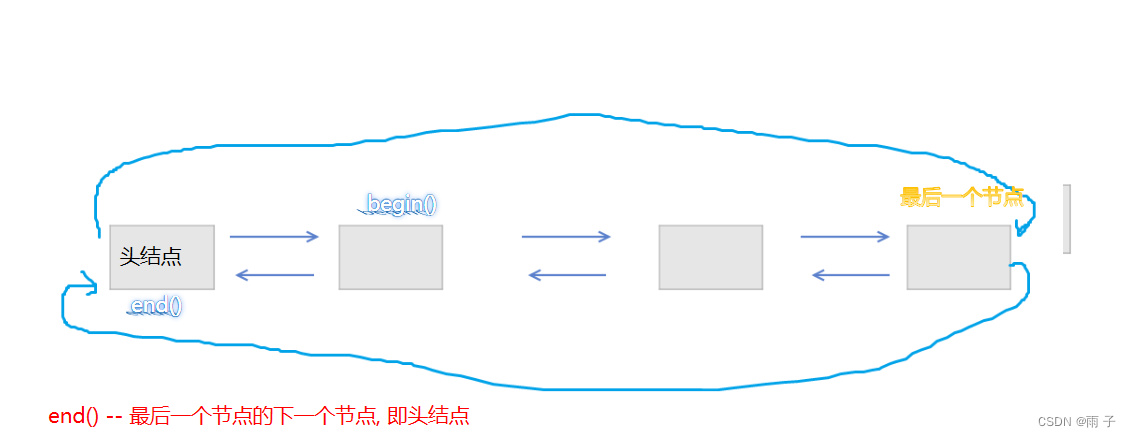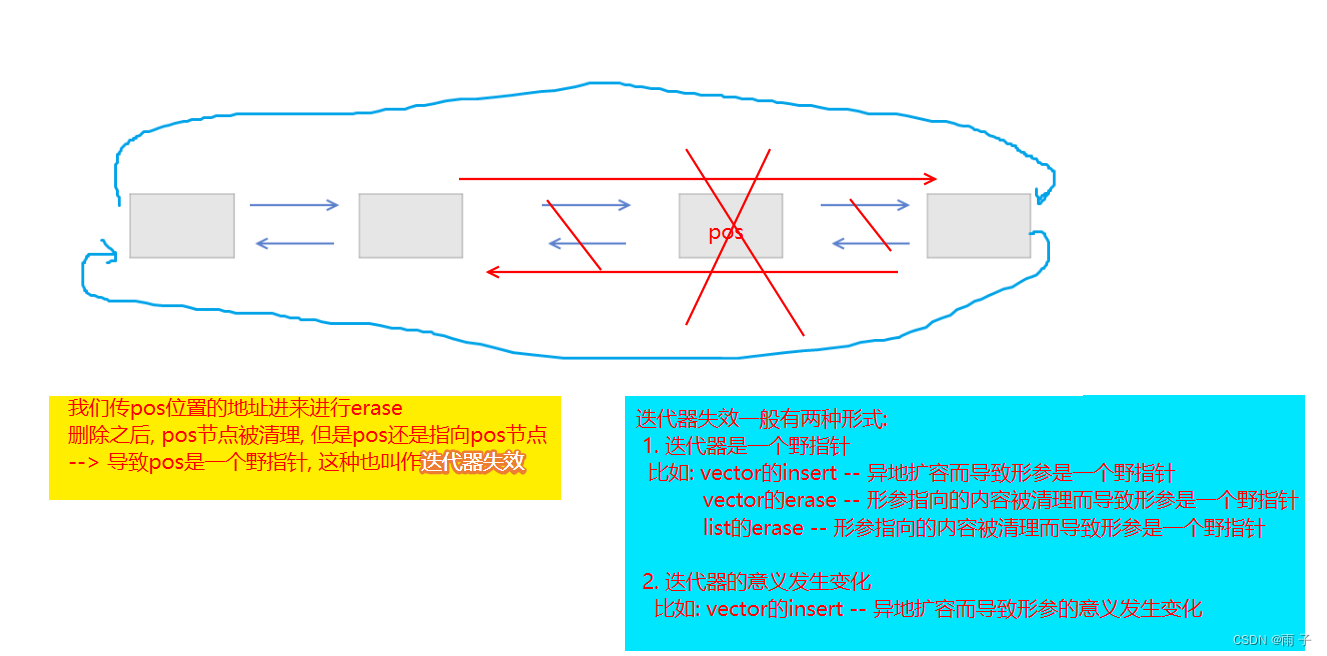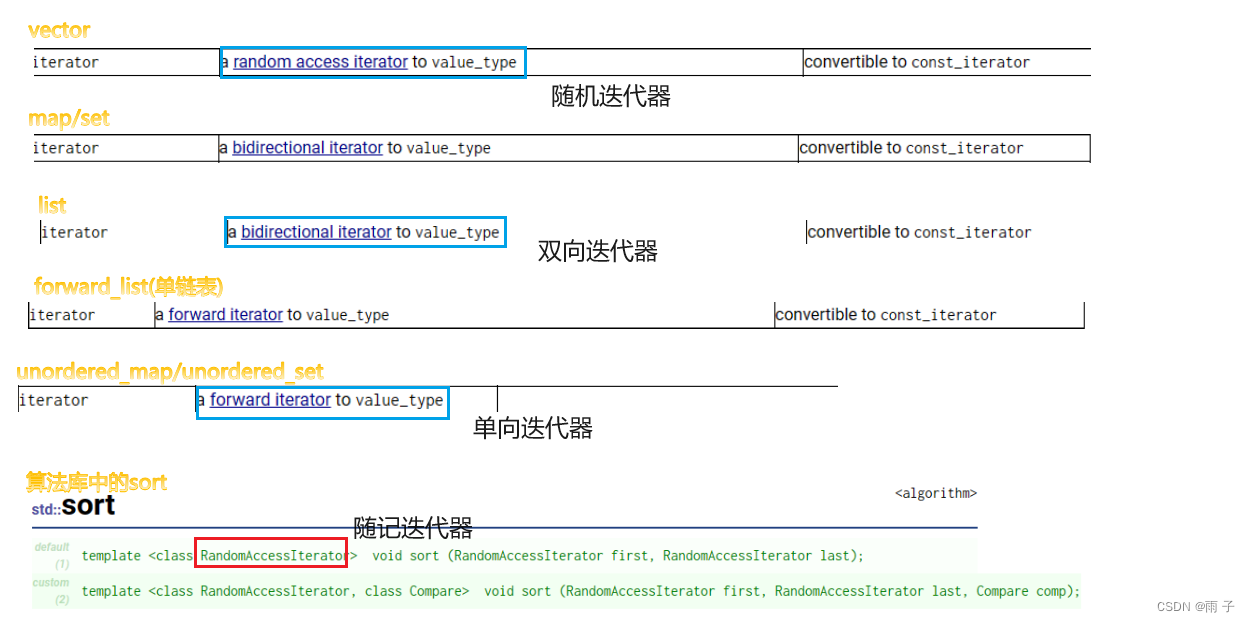list使用
- 构造函数
- insert && 迭代器
- push_back && pop_back && push_front && pop_front
- erase
- sort && find && reverse
list的底层结构就是带头双向循环链表
构造函数

// 默认构造
list<int> lt;
cout << "lt->";
for (auto it : lt)
{cout << it << " ";
}
cout << endl;// 用n个val来进行初始化
list<int> lt1(10);
cout << "lt1->";
for (auto it : lt1)
{cout << it << " ";
}
cout << endl;list<int> lt2(10, 1);
cout << "lt2->";
for (auto it : lt2)
{cout << it << " ";
}
cout << endl;// 迭代器区间进行初始化
list<int> lt3(lt2.begin(), lt2.end());
cout << "lt3->";
for (auto it : lt3)
{cout << it << " ";
}
cout << endl;// 拷贝构造
list<int>lt4 = lt3;
cout << "lt4->";
for (auto it : lt4)
{cout << it << " ";
}
cout << endl;
运行结果:
lt->
lt1->0 0 0 0 0 0 0 0 0 0
lt2->1 1 1 1 1 1 1 1 1 1
lt3->1 1 1 1 1 1 1 1 1 1
lt4->1 1 1 1 1 1 1 1 1 1
insert && 迭代器



看来list并没有 重载 + 运算符
但是重载了++
list<int> lt2(10, 1);
cout << "lt2->";
for (auto it : lt2)
{
cout << it << " ";
}
cout << endl;cout << "插入->";
lt2.insert(lt2.begin()++, 10);
for (auto it : lt2)
{cout << it << " ";
}
cout << endl;
运行结果:
lt2->1 1 1 1 1 1 1 1 1 1
插入->10 1 1 1 1 1 1 1 1 1 1
如果, 我们想要在 第五个位置进行插入该怎么办?
list<int> lt2(10, 1);
cout << "lt2->";
for (auto it : lt2)
{
cout << it << " ";
}
cout << endl;// 先找到下标为5的迭代器
auto it = lt2.begin();
for (int i = 0; i < 5; i++)
{++it;
}list<int>::iterator c = lt2.insert(it, 50);
cout << "插入->";
for (auto it : lt2)
{cout << it << " ";
}
cout << endl;cout << "insert返回值的解引用->" << * c << endl;
运行结果:
lt2->1 1 1 1 1 1 1 1 1 1
插入->1 1 1 1 1 50 1 1 1 1 1
insert返回值的解引用->50
list迭代器遍历时,while循环的判断条件只能是!=,不能是<

list<int> lt2(10, 1);
cout << "lt2->";
for (auto it : lt2)
{
cout << it << " ";
}
cout << endl;// 迭代器遍历
list<int>::iterator it = lt2.begin();
cout << "迭代器遍历->";
while (it != lt2.end())
{cout << *it << " ";++it;
}
cout << endl;
运行结果:
lt2->1 1 1 1 1 1 1 1 1 1
迭代器遍历->1 1 1 1 1 1 1 1 1 1
push_back && pop_back && push_front && pop_front
list<int> lt2(5, 1);cout << "lt2->";for (auto it : lt2){cout << it << " ";}cout << endl;lt2.pop_back();lt2.pop_back();lt2.pop_back();lt2.pop_back();cout << "尾删->";for (auto it : lt2){cout << it << " ";}cout << endl;lt2.push_back(13);lt2.push_back(30);lt2.push_back(45);lt2.push_back(6);lt2.push_back(60);lt2.push_back(5);lt2.push_back(7);cout << "尾插->";for (auto it : lt2){cout << it << " ";}cout << endl;lt2.pop_front();lt2.pop_front();lt2.pop_front();lt2.pop_front();lt2.pop_front();cout << "头删->";for (auto it : lt2){cout << it << " ";}cout << endl;lt2.push_front(25);lt2.push_front(55);lt2.push_front(9);lt2.push_front(6);lt2.push_front(20);cout << "头插->";for (auto it : lt2){cout << it << " ";}cout << endl;
运行结果:
lt2->1 1 1 1 1
尾删->1
尾插->1 13 30 45 6 60 5 7
头删->60 5 7
头插->20 6 9 55 25 60 5 7
erase

// 删除lt2中的所有奇数
auto it = lt2.begin();
while (it != lt2.end())
{if ((*it) % 2 == 1){// erase返回删除后的下一个节点的地址 -- 更新了itit = lt2.erase(it); }
else{// 不是奇数, 那就++it++;}
}
cout << "删除所有奇数->";
for (auto it : lt2)
{
cout << it << " ";
}
cout << endl;
运行结果:
lt2->1 1 1 1 1 1 13 30 45 6
删除所有奇数->30 6
但是我们需要注意: erase的形参是不能再使用的, 切记!切记!

sort && find && reverse
当我们调用 算法库中的sort:


🗨️这是怎么一回事?
- 其实, 迭代器可以按照性质(
有底层结构决定)来进行划分:
单向迭代器 – – 可以进行 ++
比如: forward_list/ unordered_map/ unordered_set
双向迭代器 – – 可以进行 ++/ –
比如: list/ map/ set
随机迭代器 – – 可以进行+/ - / ++/ –
比如: vector/ deque/ string

但是std::sort的迭代器使用的是 随机迭代器类型 ⇒ 故 list不能使用算法库中的sort算法
但list类中自带sort算法👇👇👇

//sort(lt2.begin(), lt2.end());
lt2.sort();
cout << "升序->";
for (auto e : lt2)
{cout << e << " ";
}
cout << endl;lt2.sort(greater<int>());
cout << "降序->";
for (auto e : lt2)
{cout << e << " ";
}
cout << endl;
运行结果:
升序->1 5 6 7 13 30 45 60
降序->60 45 30 13 7 6 5 1
温馨提示:
list自带的排序很慢的, 小数据量(<10万)的可以用用,
但大数据量还不如 将数据拷贝到vector中, vector排好序之后, 再将结果拷贝回去快
⇒使用好 对应的容器, 对效率来说很重要的
find函数list并没有, 但是可以用算法库中的

list函数自带reverse函数, 但其实还不如用库里的


学须反己。若徒责人,只见得人不是,不见自己非。若能反己,方见自己有许多未尽处,奚暇责人? — — 王阳明
译: 有位朋友经常因为生气而指责别人。王阳明告诫他说:“学习应该反身自省。如果只去指责别人,就只能看到别人的错误,就不会看到自己的缺点。若能返身自省,才能看到自己有许多不足之处,哪还有时间去指责别人?
舜的弟弟叫象,象屡次想害死舜,但舜还是照样疼他。王阳明说,舜之所以能感化象的傲慢,最主要的就是舜不去看象的不是。如果舜坚决要去纠正象的奸恶,只会看到象的不是,而象又是一个傲慢的人,肯定不会认错,舜又岂能感化他?” 这位朋友听了这番话,甚感惭愧。
)















 - Dockerfile)

之jackson配置前后端交互下划线转驼峰对象序列化与反序列化)
